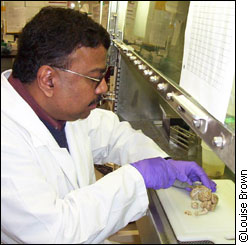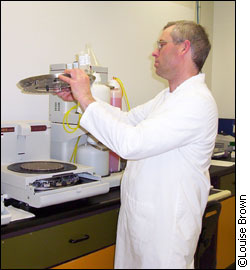| Are
prions on your plate?
By Louise Brown
OTTAWA
— Since the discovery of two cases of mad cow
disease in Alberta, Canadians have been eating more,
not less beef.
While beef exports have declined
dramatically, Canadians have actually increased their
beef consumption by 1.6 per cent over the past five
years.
 |
| Dr. Aru Balachandran says
that the risk facing Canadians from Mad Cow Disease
is minimal. |
Behind this small, but relevant
statistic is a long story. The personal decisions that
Canadians have made about eating beef are intriguing,
given the amount of negative media coverage that mad
cow disease gets and the uncertainties regarding the
science of mad cow.
A risk assessment done by Health
Canada for the time period before 1997 rated Canada
as a “negligible risk” for mad cow disease.
Since then, they have labeled Canada to be a minimal
risk for finding the disease among cows. By continuing
to consume beef products, it seems that Canadians trust
this advice and have not changed their eating habits
considerably.
According to Dr. Bill Leiss, however,
these studies are completely irrelevant. “A risk
assessment is supposed to look ahead, that’s what
they have refused to do.”
Leiss is one of the project directors
at the McLaughlin Centre for Population Health Risk
Assessment at the University of Ottawa. He says, “They
don’t have a clue about what’s going to
happen after 1997.” He adds that Health Canada
has never asked him for help in calculating this risk.
But Dr. Andre Turcotte, a specialist
in public policy analysis, says this isn’t a valid
argument. “Unless the spread of the disease is
proven to occur quicker than it used to, whatever was
going on prior to 1997 is applicable to today.”
Summing up the status of mad cow
disease in Canada in one word takes a lot of math and
science. The word minimal did not just materialize at
the whim of Canadian politicians and cattle ranchers.
Many different factors must be taken into account before
the Canadian government can advise the public about
the risks of eating beef.
First, the hazard itself must be
identified. Right now, the theories surrounding BSE
are far from being complete. Transmissible spongiform
encephalopathies (TSEs), like mad cow disease, kuru
in humans, scrapie in sheep and chronic wasting disease
in elk and deer, are all rooted in the theory of prions
(pronounced PREE-ahns).
Prions are microscopic-sized specks
of protein floating around the body. Brains, for example,
are made up of millions of specks of protein. Scientists
don’t know quite how, but bad prions (called PrPSc)
cause changes in good prions (PrPC). They seem to act
like a virus because they multiply, but they don’t
have any genetic information, which eliminates them
from the virus category.
Think of prions as the kid at school
who is a bad influence on the other kids. Prions attach
themselves onto functional pieces of protein and change
their structure. The changed proteins have now been
converted and can influence more good protein bits into
developing bad qualities as well. In this way, the disease
multiplies and eventually forms holes in the brain,
inevitably shutting down an entire nervous system.
The disease that is thought to be
transferred from cows to humans through prions is called
variant Creutzfeldt-Jakob disease. It brings a lot of
nasty psychiatric effects, like frightening hallucinations,
vivid delusions of reality, extreme forgetfulness, and
eventually death. The patient is also aware of his or
her mental deterioration as death approaches.
The second phase of a risk assessment
looks at exposure. Potentially, bad prions from cows
can be transmitted through many different routes. Most
scientists believe that staying away from eating food
made of brain or spinal cord material will stave off
the illness. In other words, any sausages and “mystery
meat” products should be considered a hazard.
Scientists also have not come to
a conclusion on this part of the theory. They don’t
know how, or if, the disease jumps from species to species.
Dr. Aru Balachandran from the Canadian Food Inspection
Agency is an expert on TSEs. “There is a theory
that prions could jump, but I trust science to a greater
extent than I do magic.”
He says there are subtle differences
at the molecular level, between the prions that devastate
different species. Cows are affected by a certain prion,
and the prion that kills humans is another type of prion,
which is structured in a different way. If the theory
of prion transfer between species turns out to be true,
one thing is for sure, he says, “It’s very
difficult to break the species barrier, but [transmission
is] less difficult within species.”
Another way of interpreting the
jumping theory is that the prions must express a change
in structure to facilitate a jump between species. In
many scientific circles, this can also be seen as the
reason for the molecular differences between species.
Genetic makeup determines human disease
There are still more mysteries about
whether genetics determines susceptibility to a bad
prion’s nasty effects. This is also something
Dr. Balachandran believes in. “Genetics plays
a role in determining who contracts the disease,”
he says.
Leiss agrees. “Of the 140-145
people who’ve died so far, almost all of them
had a kind of signature genetic makeup that made them
susceptible to getting sick,” he says. “So
that’s sort of comforting to the rest of us.”
Meanwhile, a few other scientists believe bad prions
can affect anyone who comes into contact with infected
cow brain or spinal cord material.
The third part of an assessment
is identifying “the dose,” or how much of
a substance must be consumed before a person gets sick.
Leiss says this is the most difficult part of studying
risk. “If I know how much you have, I can tell
you what the probability is that you might get sick.
That’s where the numbers come in.”
And there are more than enough numbers.
One of the concepts Health Canada has used to try to
determine the risk of mad cow disease is probability.
Dr. Turcotte says probability is the process of “trying
to isolate the chances that something will happen. We
are familiar with probability every day. When you play
the lottery, there is one chance in a million you will
win … The more tickets are sold, the less likely
you are to win. The more cows that are sold, the less
likely it will end up on your plate.”
Health Canada also looked at the
lifespan of a cow in Canada. They determined that the
average cow’s life expectancy is seven years.
“And then they looked at what they know about
the spread of the disease,” Dr. Turcotte says.
“There is a high probability that the cow will
die before contracting mad cow disease.”
But scientists don’t seem
to be in agreement with this point, as many say it is
likely that the cow could be incubating the disease
without showing any symptoms. Dr. Turcotte says that
“it looks like contracting the disease takes longer
than the lifespan of a cow. At the end of the day, the
likelihood that the steak on your plate is infected
is really remote.”
 |
| Lab technician, Steve Foster
does not worry when he handles potentially infected
brains. |
So the risk of mad cow disease to
the average person looks small, for now. When the most
recent Health Canada study becomes public, it may show
a clearer picture of this risk. Meanwhile, Steve Foster,
a technician in Dr. Balachandran’s lab, says that
working with potentially infectious material doesn’t
worry him at all.
“Sometimes I go down to the
cemetery near my house and I look at the tombstones
there. A long time ago, children died very young. We
live in good times compared to the early 1900s,”
he says. “When so many people die of cardiovascular
diseases each year, I don’t think we have to worry
about the one in a million stuff … I have to watch
my cholesterol, so I figure that’s what’s
going to eventually nail me.”
|